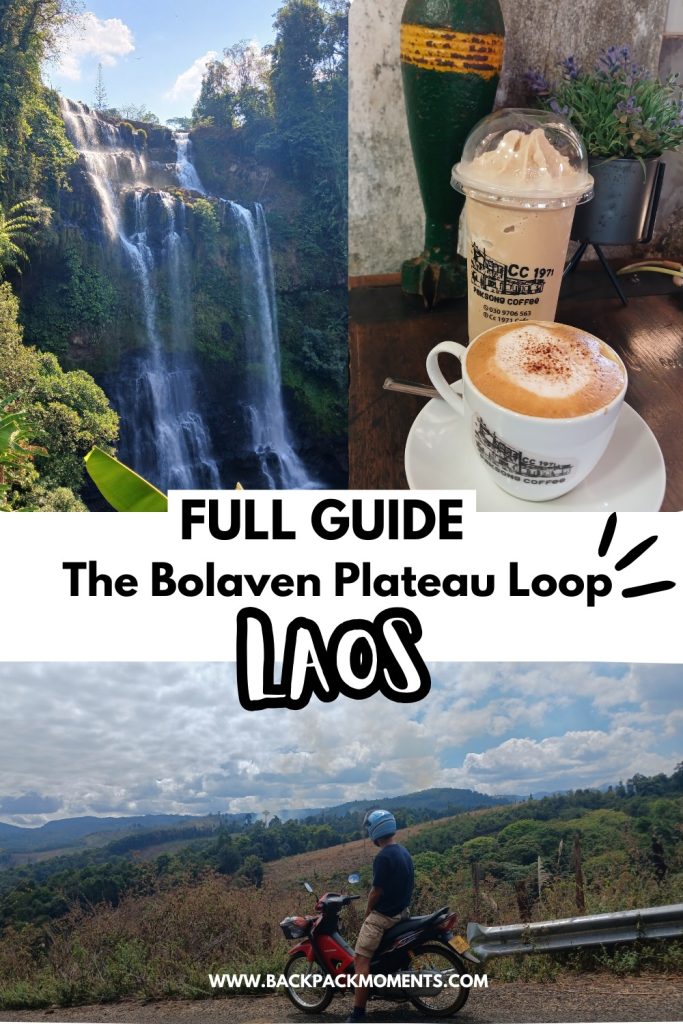The Bolaven Plateau Loop: The Full Guide (2024)
Who knew South Laos hides so many waterfalls, good coffee, and rural landscapes? Okay, the last one applies to all of Laos, but the first two should be reasons enough to visit Pakse and circle the region known as the Bolaven Plateau.
For total freedom and the option to go everywhere, stop anywhere, and spend as much time as you like, it’s best to rent a motorcycle and go on what’s come to be called The Bolaven Plateau Loop.
All variations of the Bolaven Loop start and end in Pakse and this guide will give you absolutely everything you need to know and enjoy this lesser-known region of Laos.
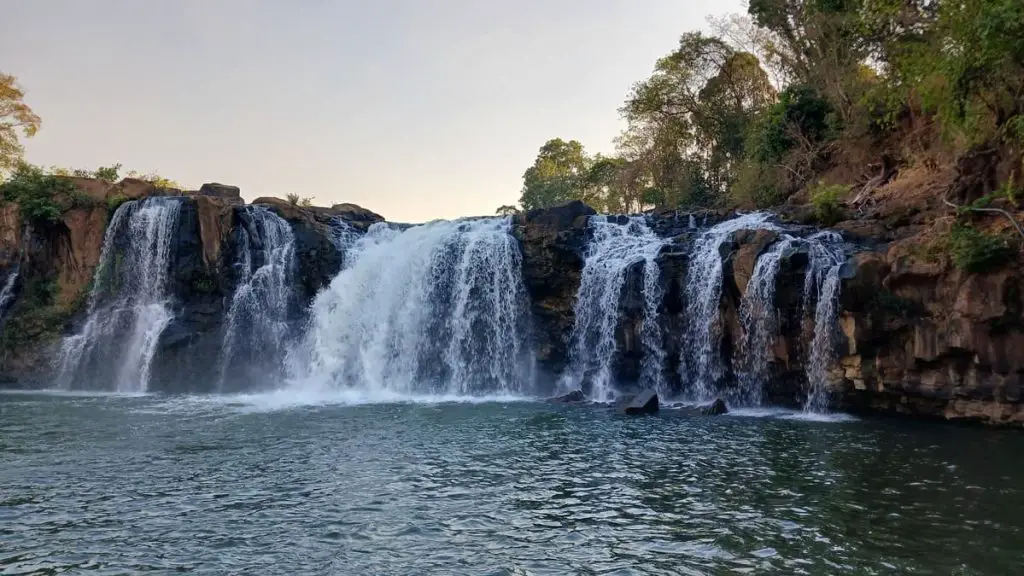
Bolaven Plateau Loop Quick Facts
The Bolaven Plateau is an elevated region in South Laos known for its waterfalls and coffee. It’s best explored by motorcycle for complete freedom and to be able to reach all of the cool places.
The Bolaven Loop is also called the Pakse Loop as it starts and ends in Pakse, the biggest city in the region. Other notable towns on the Bolaven Plateau are Tad Lo, Xekong, Houay Kong, and Paksong.
- Time needed: 2 days for the Small Loop or 3-4 days for the Big Loop
- Distance: 200 km on the Small Loop or 280-340 km on the Big Loop
- Attractions: Waterfalls, natural pools, coffee, quaint villages
- Difficulty: 1/5. Certain sections leading to the waterfalls are 3/5.
- Cost: ~16-22$ per day (incl. motorcycle rental, accommodation, food, coffee, entrance fees)
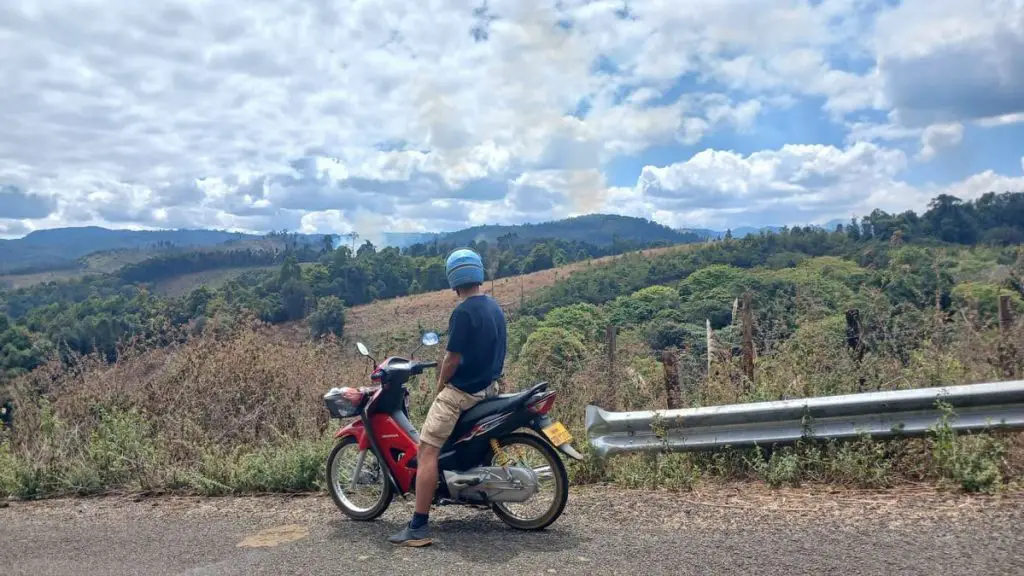
Bolaven Plateau Maps
Option 1 for a map is this custom Google Map from yours truly:
Option 2 is to download a GPS file of the Bolaven Loop. On the same page, you can also find maps of Pakse, Champasak region, 4000 Islands, and other tools and tips.
After you download the map (the GPS file) it automatically integrates with Maps.me and shows all routes, notable stops, and interesting places on the Bolaven Plateau.
Option 3 is to use a simplified paper map and do the Bolaven Loop the old-school way without GPS (or to complement the online map). You can either download and print this map or get the same paper map from Miss Noy Motorbikes in Pakse.
Note that online the map is regularly updated whereas Miss Noy may be using an outdated map. Road conditions in this region of Laos change frequently.
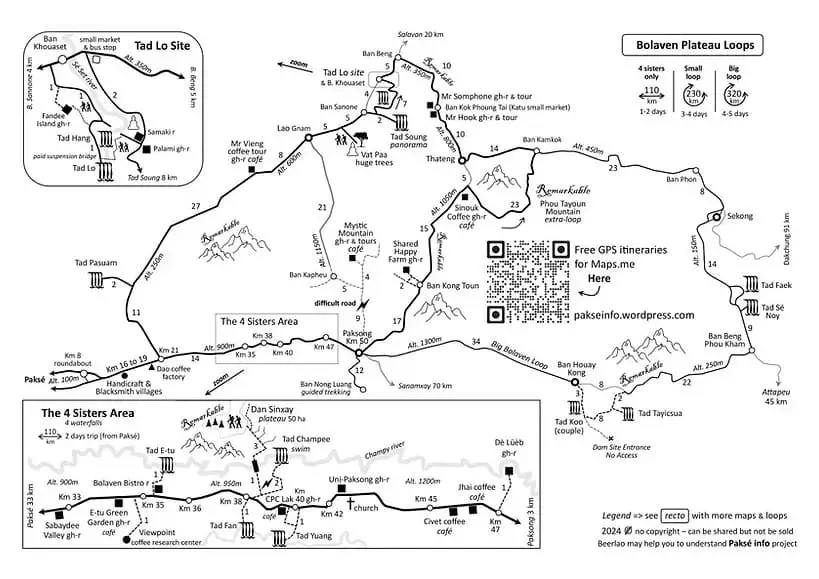
The Small Loop vs The Big Loop
The Small Bolaven Loop is around 200 km, takes 2 days (1 night) to complete, and goes through most of the must-see spots and waterfalls.
The Big Bolaven Loop is up to 340 km and takes 3 or 4 days (2-3 nights) to complete. The most noteworthy place it adds to the itinerary is the Tad Tayicsua waterfall with its 4 smaller brothers.
Everything you see on the Small Loop you also see on the Big Loop except for the section between Thateng and Paksong which doesn’t have many attractions. In other words, the Big Loop only adds but doesn’t replace interesting places.
I did the Big Loop. The roads are good but not remarkable in any way. Tad Tayicsua is impressive, although if you’re going to see the 7+ waterfalls on the small loop, it can become a bit too many waterfalls. A waterfall overload in a way.
Nevertheless, if you have the time to spare, I recommend you do the Big Loop and spend 4 days and 3 nights (in Tad Lo, Houay Kong, and Paksong respectively) on the Bolaven Plateau.
Bolaven Plateau Loop 4-Day Itinerary
The following is my itinerary on the Bolaven Plateau. I went clockwise, so as to leave the Four Sisters Waterfalls (Tad Fane, Tad Gneuang, Tad Champee, and Tad E-tu) for last.
You can do the Loop counter-clockwise, shorter, longer with more stops or with detours – it’s really up to you. But this itinerary covers the basics of the Big Loop.
Day 1: Pakse to Tad Lo
Distance:
90 km
Driving time:
~2.5 hours
Notable stops:
- Tad Phasouam
- Mr. Vieng Coffee Plantation
- Big Buddha
- Tad Lo & Tad Hang
Accommodation:
- Mamapap
- Palamei
- Samaki
The first day is all about taking your time and easing into the vibe of the Bolaven Plateau.
The roads are nice and there aren’t many notable stops, so you can arrive in Tad Lo village early and relax by the waterfall in the afternoon.
Tad Phasouam is an optional waterfall just 2 km off the main road. It’s abandoned but the road is still traversable.
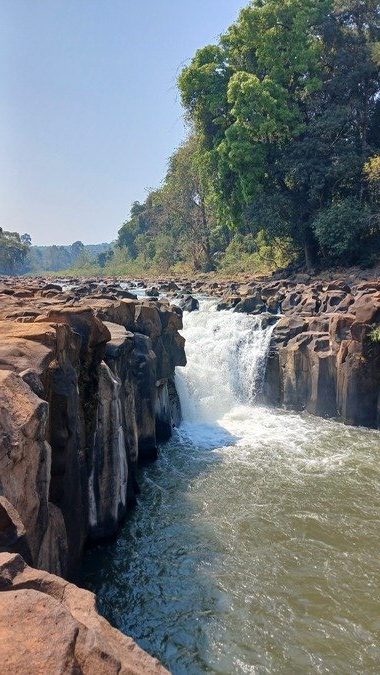
27 km further is Mr. Vieng’s Guesthouse and coffee plantation. He does tours every day at 11:30 and 13:30, which travelers report are informative and interesting.
I had coffee there, a latte for 30.000 LAK (1.5$), which tasted like filter coffee with a creamer and some water. Cannot recommend.

15 km further is a turn to the right on a 1 km-long dirt road that leads to a Big Buddha statue surrounded by what are reportedly more than 1000-year-old trees. Worth the short stop.
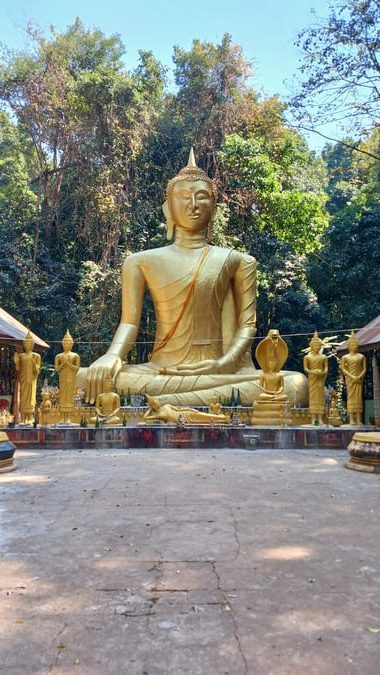
A good place to stop for lunch is this restaurant, just 4 km before Tad Lo. The food was tasty and cheaper than in Tad Lo.
The terminus of Day 1 is Tad Lo, a cute small village, that is at its core a haven for backpackers and tourists alike. Maybe a bit too much even as the prices are higher than other similar villages on the Loop.
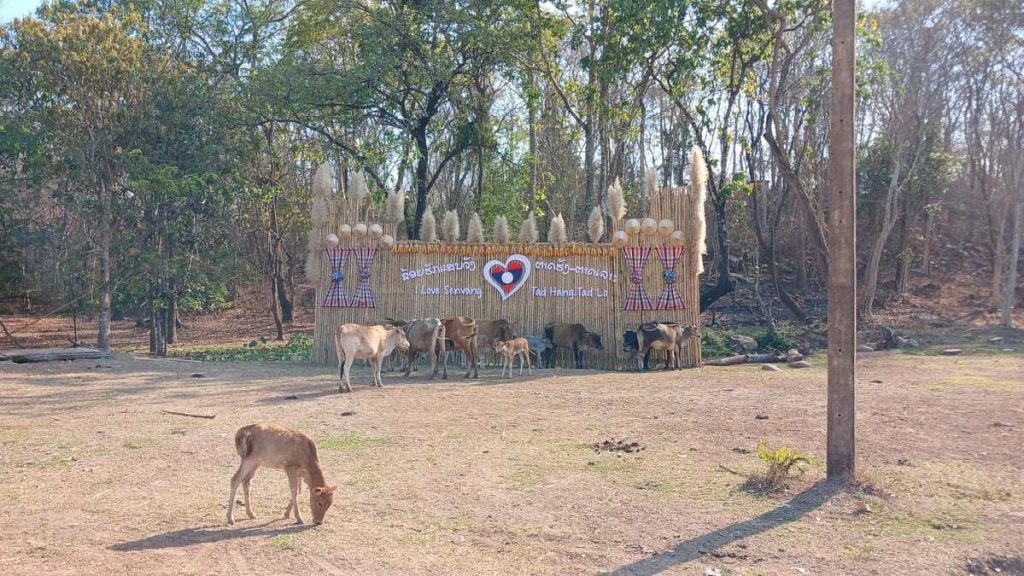
Don’t forget to check out Tad Lo waterfall which gave the name to the village (not the other way around) but I’d sabotage the elephant bathing show as who knows how the elephant is treated behind closed doors – probably not good at all.
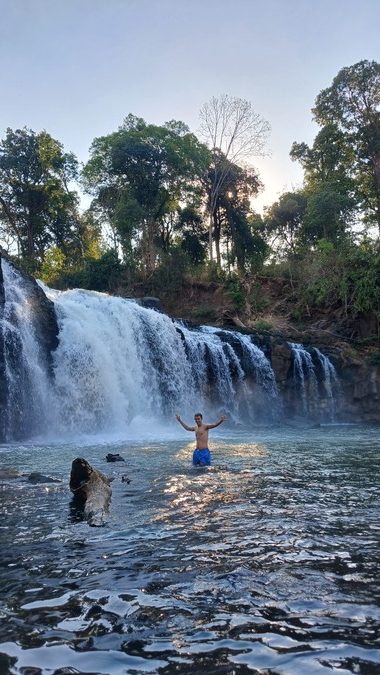
Day 2: Tad Lo to Houay Kong
Distance:
145 km
Driving time:
~4 hours
Notable stops:
- Kok Phoung Tai village
- Tateng Farm coffee
- Tad Faek
- Tad Hua Gan
Accommodation:
- Platinum
- H Thida
The second day sees you driving the longest distance out of the 4 days and looping around the Big Loop, ending the day at Houay Kong, near Tad Tayicsua.
I started the day with Mamapap’s famous giant pancakes. Big, tasty, but overpriced.

A possible first stop is Kok Phoung Tai – a village where Mr. Somphone does daily tours at 9 AM. Reportedly, this man can speak for hours and is knowledgeable in all things Bolaven. You can spend all day in his company.
If you’re not going on the tour, another reason to stop is to see the exotic foods sold at the local market. I’ll leave it up to the imagination and curiosity.
Next on is Tateng Resort where you can have good quality coffee. The resort is otherwise too fancy if you’re on the Bolaven Plateau to experience local life.
From there, do the extra small loop around the mountain. There’s a small road in awesome condition that ends in Khamkou back on the main road. The views are nice, just note that the gradient on some sections is up to 10%.
From there, it’s a rather boring drive to Sekong (or Xekong) where you can have lunch. There are plenty of options on the main road.
15 km south is Tad Faed (or Tad Faek) – a free waterfall usually frequented by locals. Swimming under the waterfall is officially forbidden by the signs but just a little further and the natural pool is perfect.
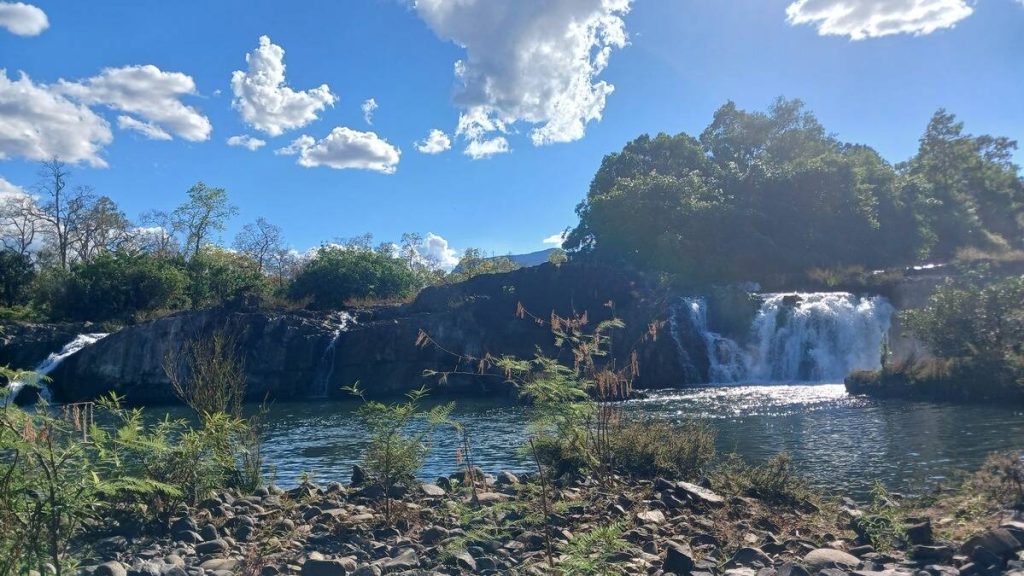
Tad Hua Gan is 3 km away and also worth a brief stop, although it’s nothing magnificent.
Make sure to leave Tad Faed at least 2 hours before sunset to avoid driving after dark. There are guesthouses in Phou Kham just before the turn towards Houay Kong if it starts getting late.
After that intersection, the road slowly slopes up as you enter the Plateau again, this time from the east. Make a short stop to see Tad Katamtok from afar.
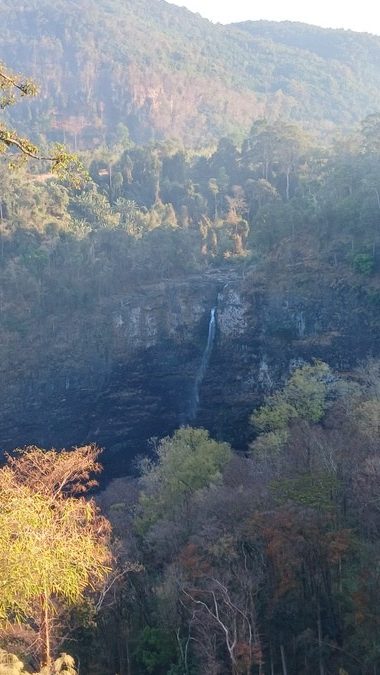
End the day at Platinum Guesthouse in Houay Kong which offers superb quality for very little money. Choose one of the local eateries for dinner.
Day 3: Houay Kong to Paksong
Distance:
60 km
Driving time:
~2 hours
Notable stops:
- Tad Tayicsua
- The wonderful area around
- 3 more waterfalls
Accommodation:
- Savanna
Day 3’s main event is Tad Tayicsua, commonly given the title of the most beautiful waterfall in the Bolaven Plateau.
From your accommodation in Houay Kong, a dirt road will take you to Tad Koo (transformed into a tacky touristy establishment) and then to Tad Diev (a small abandoned waterfall).

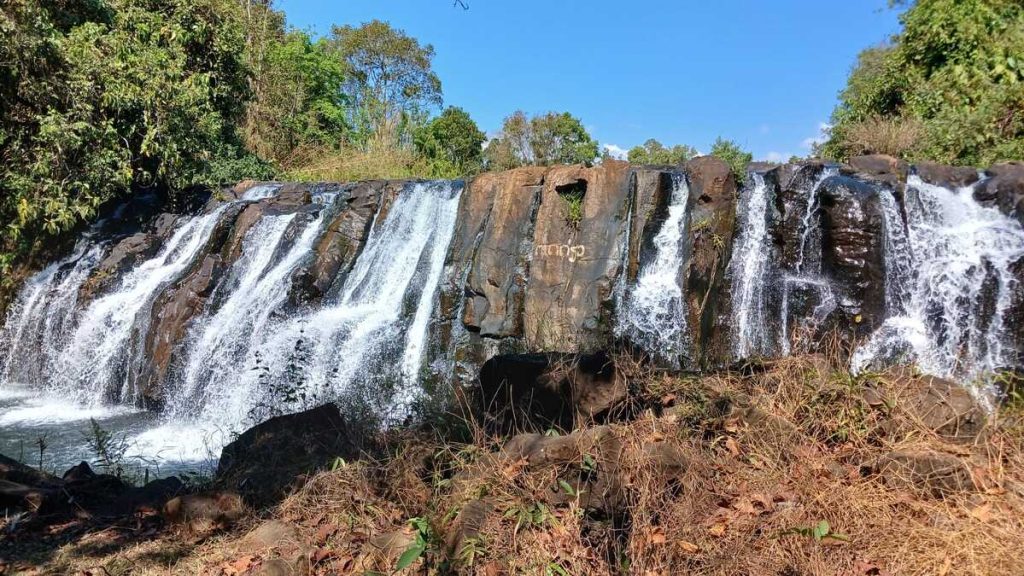
Continue further until you reach Tad Tayicsua Homestay where you can park your motorcycle.
The viewing platform presents an outstanding view of the waterfall and the whole area underneath. A new set of 362 metal stairs leads you down to the base of Tad Tayicsua where you can feel the breeze of the falling water.

If your legs are not cheese by the time you go back up, venture into the jungle for the other 3 waterfalls. I only visited Tad Jarou Halang – a tall waterfall where, if the conditions are right, you can see a circular rainbow.
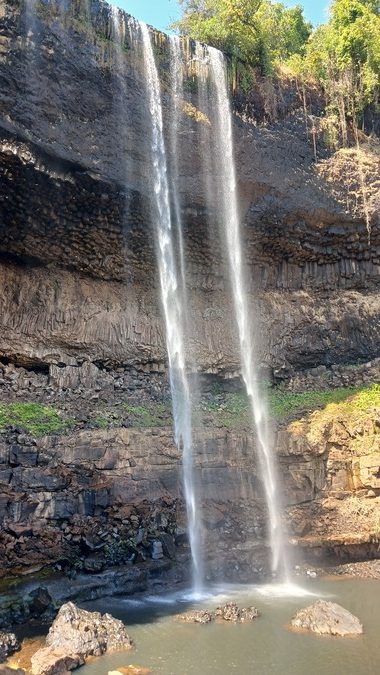
The paths to all three waterfalls are steep and although as short as 200-300 meters, can take up to 20 minutes to walk.
You can easily spend the whole day in the area around Tad Tayicsua. There aren’t any other attractions to visit on Day 3, so when you’ve had enough fire up the engine again and drive the 45 km to Paksong.
Day 4: Paksong to Pakse + (Optional) Vat Phou
Distance:
50 + 90 km
Driving time:
~2 + 2 hours
Notable stops:
- CC 1971 cafe
- Four Sisters Waterfalls Group
- Vat Phou (Optional)
Accommodation:
- Kaemse
Day 4 goes through the most popular waterfalls on the Bolaven Plateau Loop – the so-called Four Sisters.
First off though – COFFEE!
Check out CC 1971 cafe – both the interior and the exterior are like they were after the bombings of 1971. Their coffee is superb!

12km west of Paksong is Tad Genuang, a powerful waterfall with some 194 stairs leading down to its base. The entrance fee is 20.000 LAK with 5k more for parking. There’s a small gazebo facing the waterfall where you can enjoy the views and the thundering sound of the water for a while.
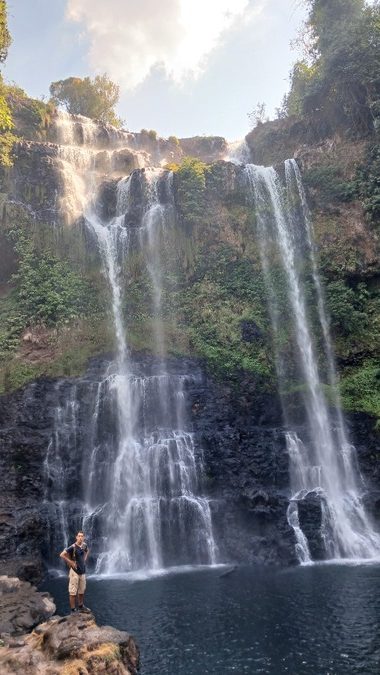
There is a 2 km pathway that connects Tad Gneuang to Tad Fane, which is unfortunately overgrown with vegetation and no longer accessible.
On the other side of the main road is Tad Champee. For an entrance fee of 10.000 LAK, you get access to a pathway going behind the water curtain. The natural pool is perfect for swimming and the area is picturesque.
Further east is the jewel of the Bolaven Plateau – Tad Fane, the highest waterfall in Laos.

Here comes my painfully honest verdict: not worth the 20.000 LAK fee. You can only see the dual falls from a mile away and the area is dominated by the Tad Fane resort, making everything extremely touristy.
There’s a zip-line that loops around the area over 4 rides but it costs 35 USD which is quite expensive, but also probably quite fun. To avoid having to carry a lot of cash, buy a voucher from Miss Noy before you depart for the Loop and then pay when you return ONLY if you’ve actually used it.
The last of the 4 sisters is Tad E-tu. There used to be a resort there which now lies abandoned with creepy-looking hollowed-out cars and faded signs. the 282 steps that lead down to the waterfall remain. It’s an awesome spot for a refreshing cold swim.
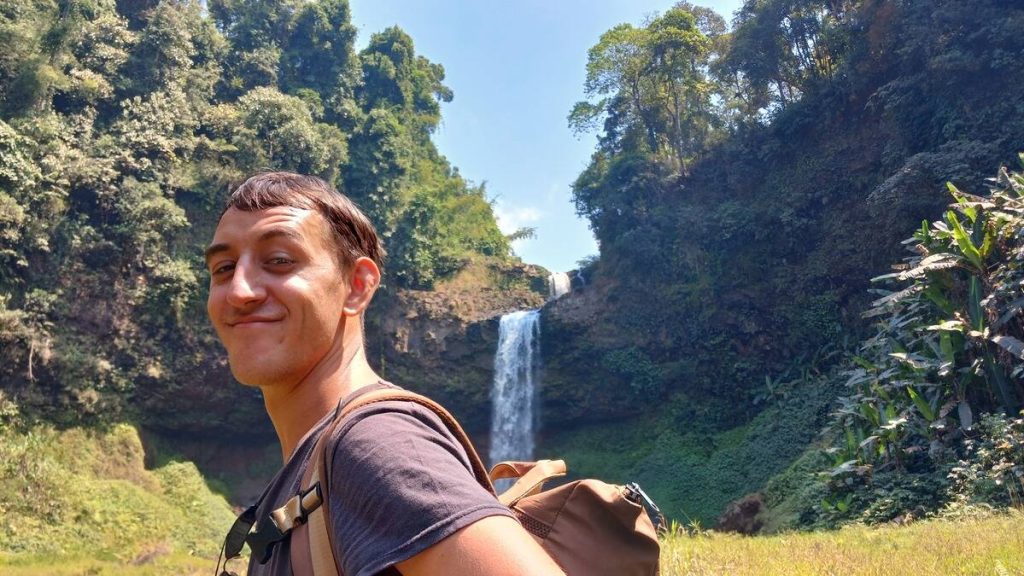
If you’re done with the loop early, you can use the afternoon to go to Vat Phou. It’s a UNESCO heritage site, reminiscent of the temples in Angkor Wat and built by the same Khmer Empire.
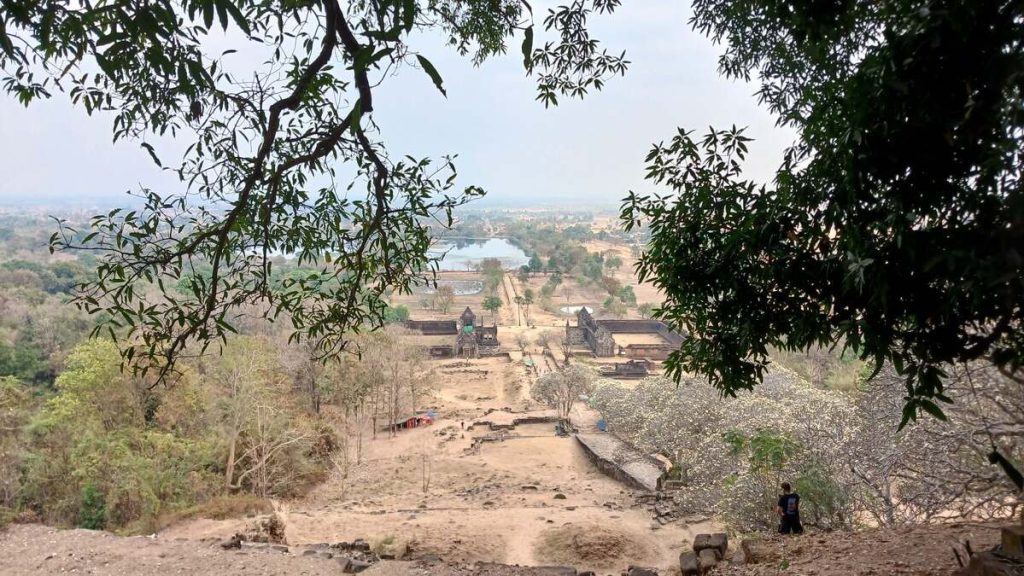
It’s not considered part of the Bolaven Plateau but is a must-visit while in Pakse, so you might as well.
Here’s my short guide to visiting Vat Phou from Pakse.
Logistics of the Bolaven Loop
Here’s the important stuff. If I’ve missed something, ask in the comments, please.
Renting a Motorcycle
Renting a motorcycle in Pakse is incredibly easy. There are a dozen specialized rental shops and almost every hotel and guesthouse also rents out motorcycles and scooters.
I recommend Miss Noy Motorbike in downtown Pakse. New motorcycles, comfortable helmets, luggage storage and you don’t need to tell them how long you’re renting for in advance.
They also do an Info Session in English (mixed with French) every day at 18:00 which is both invaluable and entertaining. Make sure to reserve a motorcycle the previous day and turn up for the session.
Motorcycle rental prices are fixed in US dollars but the Lao Kip fluctuates a lot so I’m listing the prices in USD. Read more about money in Laos for tourists.
- Semi-automatic (Honda Wave 100cc): 6$ per day (130.000 LAK at the time of writing)
- Automatic scooter (Honda Scoopy 110cc): 8$ per day (170.000 LAK)
- More powerful automatic scooter (Honda Click 125cc): 10$ per day (210.000 LAK)

My advice: rent a Honda Wave. It’s the cheapest and being able to switch to a lower gear helps with both going up and down. There are some sections on the Big Loop where a semi-automatic bike is much preferred.
Road Conditions
If you read a guide about the Bolaven Plateau Loop from 10 years ago, half the roads will be marked as “AVOID AT ALL COSTS” in danger-red.
As of early 2024, the roads on both the Small Loop and the Big Loop are pretty good. Not awesome, but for Laos standards, they are among the best: paved, with minimal holes, not wavy, and with good markings.

The sections where the roads are NOT that good (but traversable):
- 2 km section leading to Tad Phasouam (dirt road)
- 1 km section leading to the Big Buddha in the ancient trees (dirt road)
- Some parts of the 25 km extra mini loop from Tateng Farm to Khamkou (paved but up to 13% slope in some sections)
- The road from Houay Kong to Tad Ko and Tad Diev (dirt road, bumpy)
- The road from Tad Diev to Tad Tayicsua (dirt road, bumpy)
- The 3.5 km section from Tad Tayicsua back to the main road (dirt road, VERY bumpy). They were starting work on this road when I passed in February 2024. Yves from Miss Noy Motorbikes may advise you to avoid this section but if you go carefully it saves you from doing the 13 km dirt road the other way.
- The 1 km section from the main road to Tad E-tu (dirt road)
Parking
Always park in places with an attendant. Parking usually costs 5.000 LAK per bike but you get peace of mind that the motorcycle won’t get stolen.
Lock the bike (your rental should give you a lock) and lock the front tire. You can leave the helmet(s) on the bike – thieves are interested in the vehicle, not the helmets.
Overnight, most guesthouses have bike parking areas they lock during the dark hours. Keep your bike there.
If you haven’t paid for parking, don’t leave your motorcycle unattended.
Police on the Loop
Police presence on the Bolaven Plateau Loop is minimal.
There are checkpoints between regions but they don’t stop traffic.
I saw one police car checking traffic entering Pakse but they don’t stop foreigners.
I haven’t heard of anybody ever stopped by Lao police on the Bolaven Plateau. Very different than the experience on the Ha Giang Loop in Vietnam for example.
Weather
The Bolaven Plateau itself is an elevated region with its own microclimate. Some sections are as high as 1300 meters above sea level and it can get a little chilly in the evenings.
This being said, you’re still in Southeast Asia, so anything less than 20 degrees Celsius (68F) is very rare.
The dry season is between October and April. Towards the end (January, February, March) it will be dustier. During the wet season, access to some waterfalls may be difficult and muddy.
The Burning Season in Laos also affects the Bolaven Plateau. Smoke and haze may cover the skies starting in February and ending with the coming of the rain in April.
Packing List
Don’t forget these:
- Sunscreen
- Swimsuit (ladies, consider something less revealing)
- Flipflops
- Surgical face mask (optional for the very dusty sections)
Avoid white clothes as everything you wear will be very dusty by the end.
Fuel
Every village on the Bolaven Plateau has a gas station. The longest section without a gas station is the 33 km between Beng Phou Kham and Houay Kong.
Don’t let your bike go low on fuel – you never know if the next gas station isn’t out of fuel.
The price of 1 liter of fuel is around 23.000 LAK (1.1$) which amounts to around 40-50 km.
To do the Small Loop, you need around 4-5 liters of fuel.
To do the Big Loop, you need around 7-8 liters of fuel.
I drove around the Big Loop (including detours) for a total of 375 km and used around 8.5 liters of fuel. I paid 200.000 LAK (9.6$) for fuel.
Accidents
Most common reason
The most common reason for an accident on the Bolaven Plateau is animals, believe it or not.
Cows, goats, donkeys, chickens, and dogs are a common sight on the roads.
Slow down when approaching animals, especially cows. They are unpredictable.
What to do in case of an accident
If you get into an accident, animal-related or otherwise, assuming you’re physically okay, call your rental. They will know what to do. If you were looking for more insightful advice, I’m sorry to disappoint you this time.
Flat tires
Flat tires are common on the Bolaven Plateau roads. Actually, it’s more likely you get a flat tire on paved roads than on dirt roads!
This being said I was quite lucky NOT to get a flat tire in all 375 km on the Pakse Loop.
There is at least 1 mechanic shop in every village in the region. You may have to push the bike for a while if you get a flat tire between villages, but there’s not much else to do – it’s Laos: there are no roadside assistance businesses.
The price to change a tire is 40.000 LAK for a semi-automatic and 50.000 LAK for a scooter.
Accommodation
Don’t book in advance. Most places are not listed online anyway.
There are a handful of guesthouses in every notable stop on the loop. Check Google Maps or the Itinerary section above for recommendations.
Coffee Stops on the Loop
You’ve scrolled to the tasty part of the guide!
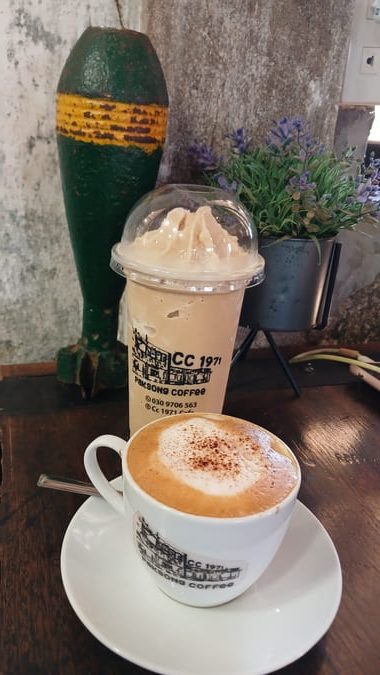
The Bolaven Plateau is elevated, meaning it offers favorable conditions for growing coffee. And coffee is indeed grown!
The French initiated the coffee industry in the early 1900s and to this day coffee is a primary agricultural sector.
You can visit coffee plantations around Bolaven (mostly on the Small Loop). Coffee houses and cafes are many and compete for the title of Best Coffee in Laos. Here are a few notable coffee stops:
- Mr Vieng Coffee Plantation. Tours at 11:30 and 1:30. The cafe is cool, set in a traditional thatched-roof house. However, their coffee is overpriced and low quality.
- Thateng Farm & Resort. As fancy as places in Bolaven go. The local vibe from elsewhere is not present here but their coffee is good and not too expensive. Bonus: Lake.
- CC 1971 Cafe. Set in a former power plant that survived the bombings of 1971. The cafe is deliberately not restored and keeps the original look of the building, along with shrapnel, artillery pieces, and dilapidated staircases. The coffee is awesome!
- Jhai Coffeehouse. The best-known cafe on the Bolaven Loop. Recently moved to this new location and everything is clean, tidy and modern with a traditional touch. The coffee is good, tasty, and well-priced.
- Coffee Garden LAK 45. Do you want a cup of the famous civet coffee? This is the place. How do you know it’s genuine and not fake as in most places in Bali? The owner has positioned the civet cats in cages on display for everyone to see. A bit sad, really – you’ve been warned.
Bolaven Plateau Waterfalls
You can more easily see the location of the most notable waterfalls on the Bolaven Plateau in the maps section above.
That’s a list of the ones you shouldn’t miss:
Small Loop Waterfalls:
- Tad Phasuam: small, abandoned, can’t swim, free
- Tad Lo: midsize, popular, can swim, free
- Tad Hang: micro, popular, can swim, free
- Tad Gneuang: big, popular, can swim, 20.000 fee, 194 steps
- Tad Champee: small, popular, can swim, 10.000 fee
- Tad Fane: tallest, can only see it from a distance, ultra-popular, can’t swim, 20.000 fee
- Tad E-tu: big, abandoned (and still quite popular), can swim, free, 282 steps
Big Loop Waterfalls:
- Tad Faek: midsize, not popular, can swim (not officially), free
- Tad Hua Gan: small, not popular, can swim, free
- Tad Koo: small, touristy, can swim, 20.000 fee
- Tad Diev: small, abandoned, can’t swim, free
- Tad Katamtok: high, can only be seen from a distance, can’t swim, free
- Tad Tayicsua group (20.000 fee for all combined):
- Tad Tayicsua: massive, not crowded, can’t swim but can go inside the water, 362 steps
- Tad Jarou Halang: big, not popular, can swim, 20 minutes walk
- Tad Jarou Mandreun: I don’t know but 20 min walk
- Tad Jarou Thalaleui: I don’t know but 20 min walk
Off the beaten track waterfalls:
- Tad Champee (another one)
- Tad Soung
- Tad Thevada
- Tad Sepa
- Tad Sae Pong Lai
Other Ways to Do the Bolaven Loop
I saw some cyclists on the Small Loop and they looked as if they were doing the full 200 km ride. It is indeed possible to do the Bolaven Plateau Loop by bicycle as long as you prepare well and are physically fit.
To do the Bolaven Loop by car, it’s easiest to hire a driver from Pakse. I don’t recommend this option as it will be costly and it’s just better on a motorcycle! But if that’s your cup of tea, take a look at this private full-day tour of the Bolaven Plateau.
Lastly, don’t feel like you have to do a circle (i.e. a loop) by any means necessary. You can do any section of the loop without going around the whole thing. Many people go to Tad Fane, Tad Genuang, and Paksong on a day trip and return to Pakse.
Bolaven Plateau Loop vs Thakhek Loop
A few hours north of Pakse is Thakhek – a bit more famous with its own Thakhek Loop.
Succinctly put, the Bolaven Plateau gives you waterfalls, dusty rural villages, and coffee. The Thakhek Loop gives you caves, karst mountain landscapes, and adventure tourism.
I liked the Bolaven Plateau more although most backpackers I met liked the Thakhek Loop more. You know what – do both!
(In)frequently Asked Questions
Which waterfall is best on the Pakse Loop?
The waterfalls I liked the most on the Bolaven Plateau Loop are Tad Tayicsua and Tad Gneuang.
How long does the Bolaven Plateau Loop take?
The Small Loop is around 200 km and takes 2 days to drive with 1 night in Tad Lo.
The Big Loop is around 340 km and takes 4 days to drive with 3 nights in Tad Lo, Houay Kong, and Paksong.
What does Bolaven mean?
Bolaven means “Home of the Laven” with Laven being the dominant ethnicity in the region.
Is the Civet Coffee sold in the cafes on the Pakse Loop worth the money?
No.
Only overly pretentious coffee connoisseurs may be able to tell it apart in a blind taste test. Just buy a regular espresso.
Check out these other motorcycle trips in Southeast Asia:
- Thakhek Loop in Laos
- Ha Giang Loop in Vietnam
- Hai Van Pass in Vietnam
